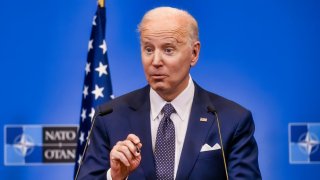Booming Economy? Joe Biden Could Soon Face a Banking Crisis
If President Joe Biden could make a wish, it would be that the presidential election took place in November 2023 rather than in November 2024. He would then have been able to run a successful election campaign based on a strong economy rather than on an economy beset by commercial property-related financial system strains.
This week, there has been some good and some bad news about our economy. The good news is that the economy continues to create jobs at a highly satisfactory pace without impeding the path to lower inflation. The bad news is that strains are clearly emerging in the financial system as a result of the serious problems in the commercial real estate sector. Those strains now risk upending the economic recovery before year-end.
Among the more surprising and welcome characteristics of today’s U.S. economy is that job creation continues at a strong pace of around 300,000 jobs a month. This is happening without preventing inflation from continuing downward the Federal Reserve’s 2 percent inflation target. Surprisingly, too, is the fact that maintaining unemployment close to a postwar low is not causing an undue acceleration in wage inflation. This is in marked contrast to what most economists had expected.
At the start of last year, the consensus was that the economy would have to go into a recession for inflation to come down. Now that this has clearly not happened, economists are starting to engage in a lot of soul-searching as to where their economic models got it so wrong.
Offsetting the good labor market news, this week, the New York Community Bank, a $100 billion regional bank, Aozora, a Japanese bank with significant U.S. commercial real estate loan exposure, and Julius Baer, a Swiss bank, all issued dismal earnings reports. Ominously, they did so due to serious commercial property loan troubles. This has heightened the chances of another round of the regional bank crisis that could derail the economic recovery. This is especially the case if the Federal Reserve is forced to maintain high-interest rates for fear that a job market that is too strong might reverse, at least in part, some of the impressive inflation reduction progress made to date.
In March last year, markets were roiled by the failure of Silicon Valley Bank and First Republic Bank. Those failures were the second and third-largest U.S. bank failures on record. They required large-scale Federal Reserve intervention to prevent the regional banks’ problems from morphing into a systemic bank crisis. The principal factor triggering those failures was the large mark-to-market losses those banks recorded on their bond portfolios as a result of the Fed-induced spike in long-term interest rates. It is estimated that for the banking system as a whole, bond-related mark-to-market losses are in the range of $600 billion.
Fast forward to today. In addition to still suffering from the damage high-interest rates are exacting on their bond portfolios, the banks are being hit hard by souring commercial property loans. These loans are souring due to record high office vacancy rates as employers have allowed a large part of the workforce to work at least part of the week from home. It is estimated that the national office vacancy rate is at a record of close to 20 percent, while in New York alone, office space equivalent to 30 Empire State buildings now sits vacant. As leases continue to expire, those vacancy rates are bound to go even higher.
Record vacancy rates are now being reflected in plunging commercial property prices. Commercial property prices have already fallen by around 16 percent since March 2022. Meanwhile, Morgan Stanley expects commercial property prices to decline by about 40 percent from their pre-Covid peak. That, in turn, is bound to induce a wave of commercial property loan defaults as property developers will find it difficult to roll over the $500 billion due to mature this year at higher interest rates.
If rising commercial property loan default rates are a problem for the banking system as a whole, they are a major problem for the regional banks. For those banks, commercial property lending accounts for close to 20 percent of their overall loan portfolio. Those banks are in no position to have to make large loan loss provisions for their commercial property lending at a time when they are still losing deposits and when they are nursing significant mark-to-market losses on their bond portfolios.
A recent National Bureau of Economic Research study underlines the dimension of the prospective regional bank crisis. It estimates that should interest rates stay at their current levels, a wave of commercial property loan defaults could result in the failure of up to 385 regional banks.
All of this suggests that if President Biden could make a wish, it would be that the presidential election took place in November 2023 rather than in November 2024. He would then have been able to run a successful election campaign based on a strong economy rather than on an economy beset by commercial property-related financial system strains.
About the Author
Desmond Lachman is a senior fellow at the American Enterprise Institute. He was a deputy director in the International Monetary Fund’s Policy Development and Review Department and the chief emerging market economic strategist at Salomon Smith Barney.
Image Credit: Shutterstock.


